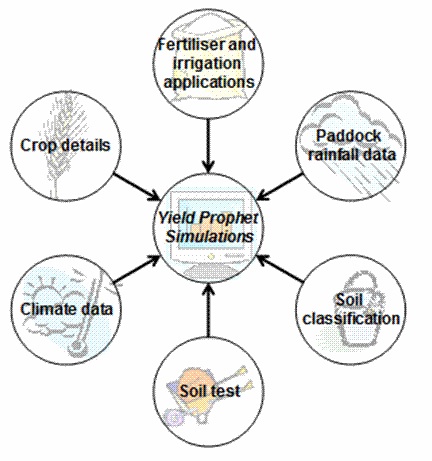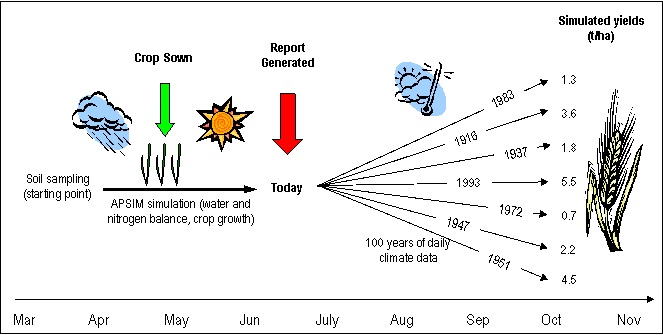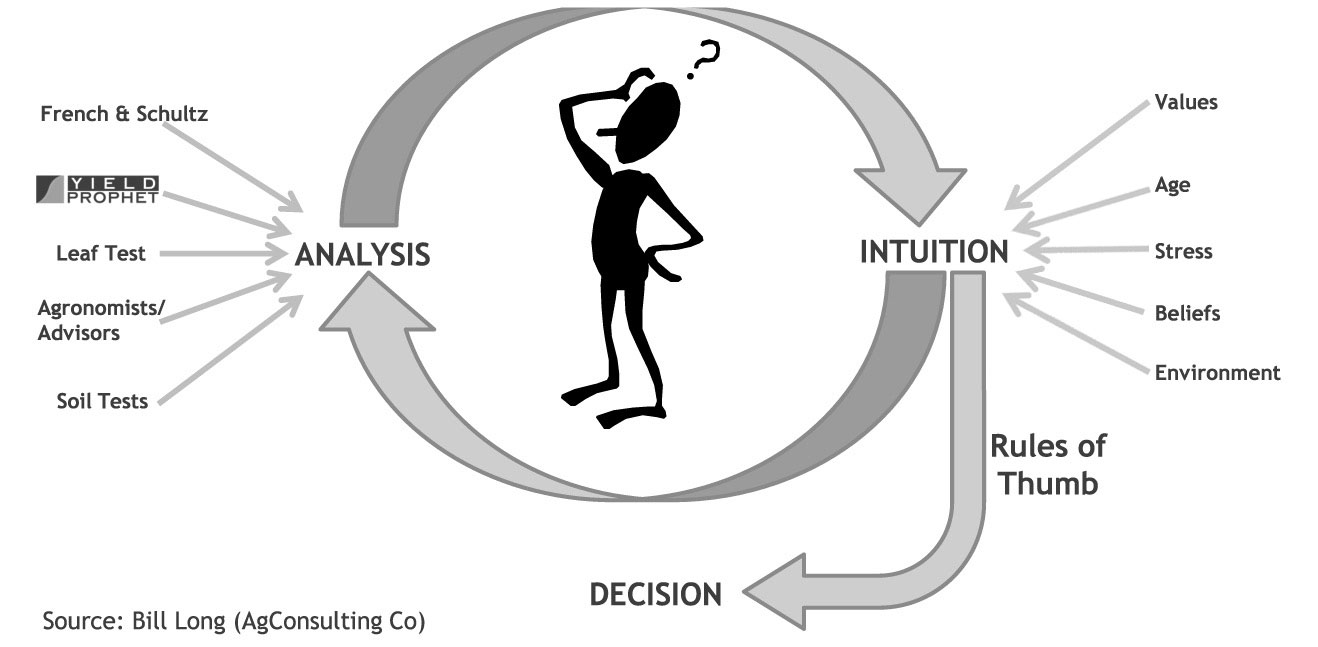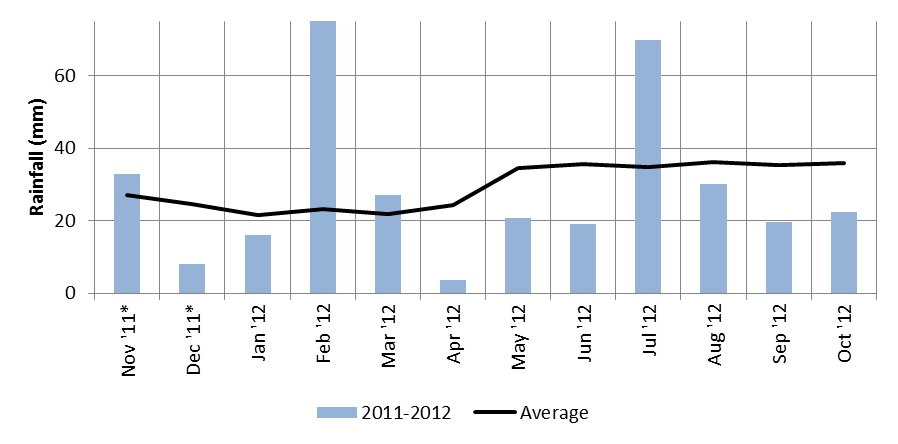Yield Prophet® - What difference can it make to crop decision making?
Author: Tim McClelland | Date: 06 Feb 2013
Tim McClelland
BCG
Take home message
- Many growers rely wholly on their experience and intuition. In the majority of cases this approach works well. However, in unique and unusual seasons Yield Prophet® is a tool that can help to correct biases in intuition.
Background
Australia’s climate, and in particular rainfall, is among the most variable on earth; consequently crop yields vary from season to season. In order to remain profitable, crop producers must manage their agronomy, crop inputs, marketing and finance to match each season’s yield potential. Scientists have aimed to support farmers’ capacity to do this by developing APSIM (Agricultural Production Systems Simulator). APSIM is a farming systems model that simulates the effects of environmental variables and management decisions on crop yield, profits and ecological outcomes. Yield Prophet® delivers information from APSIM to farmers (and consultants) to aid their decision making. Yield Prophet® has enjoyed a measure of acceptance and adoption amongst innovative farmers and has had valuable impacts in terms of assisting farmers to manage climate variability at a paddock level.
Yield Prophet® is an on-line crop production model designed to present grain growers and consultants with real-time information about their crops. This tool provides growers with integrated production risk advice and monitoring decision support relevant to farm management. Operated as a web interface for APSIM, Yield Prophet® generates crop simulations and reports to assist in decision making. By matching crop inputs with potential yield in a given season, Yield Prophet® subscribers may avoid over- or under- investing in their crop. The simulations provide a framework for farmers and advisers to:
- forecast yield
- manage climate and soil water risk
- make informed decisions about nitrogen and irrigation applications
- match inputs with the yield potential of their crop
- assess the effect of changed sowing dates or varieties
- assess the possible effects of climate change.
Farmers and consultants use Yield Prophet® to match crop inputs with potential yield in a given season. This is achieved primarily by conducting scenario analyses in which the effects of alternative management options on crop yield and potential profitability can be assessed, applied and influence decision making.
How does it work?
Yield Prophet® generates crop simulations that combine the essential components of growing a crop including:
- a soil test sampled prior to planting
- a soil classification selected from the Yield Prophet® library of ~1,000 soils selected as representative of the production area
- historical and active climate data taken from the nearest Bureau of Meteorology (BOM) weather station
- paddock specific rainfall data recorded by the user (optional)
- individual crop details
- fertiliser and irrigation applications during the growing season.

Figure 1. Diagrammatic representation of the components utilised in the generation of Yield Prophet® simulations
When a report is requested, the paddock-specific information is packed into an email and sent from the Yield Prophet® database to a computer cluster where the simulation is processed. Using climate data for the current season, Yield Prophet® simulates the soil water and nitrogen processes in the paddock together with the crop growth from the start of the season, to the present. Yield Prophet® calculates the amount of water and nitrogen available to the crop, and the crop’s water and nitrogen demands. This information is used to determine whether the crop is suffering stress from a lack of either of these resources and to assess any resultant reduction in growth and yield potential. Using historic climate data, Yield Prophet® then simulates crop growth and resource availability from the day on which the report was generated to the end of the season.
This process is repeated once for each year of climate record (~120 years) providing 120 separate yield outcomes (Figure 2). These yields are then plotted as a probability curve providing growers with an estimate of the likelihood of obtaining a range of yields. This output is then adapted to the requested report type and emailed to the website or the subscriber, where it can subsequently be viewed. Report generation takes from five to 15 minutes.

Figure 2. Visual representation of the Yield Prophet® simulation process.
What is Yield Prophet® ’s role?
Growers make decisions on farm every day. The majority of decisions made are conducted without too much thought or analysis because the consequences of those decisions are minor. The majority of these decisions are made based on intuition or experience. As the consequences associated with that decision increases the level of thought and analysis increases.
For example before a grower decides to apply additional nitrogen to their crop they may conduct a series of analyses to ensure that they are making the right decision. These may include: talking to their agronomist; checking the weather forecast; doing a back of the envelope calculation; checking a soil moisture probe for plant available water, and so on. There are a broad range of tools that growers can use to help make a decision. Yield Prophet® is just one option available.
Figure 3 shows a diagrammatic representation of the decision making process growers may go through when making a decision. The figure shows that intuition and experiences are affected by a range of different factors. Of particular note is that growers are significantly influenced by their recent experiences which often have the greatest bearing on the final outcome. Those who utilise the analysis phase are validating their intuition and correcting for any biases that may prevent an optimal decision from being made.

Figure 3: Grower decision process.
Many growers don’t use tools to help them make nitrogen decisions and they rely wholly on their experience and intuition. In the majority of cases this approach works very well and will often give the desired result. However, in seasons that could be considered unique or unusual, experience and intuition can start to break down; 2012 was a prime example.
Yield Prophet® Birchip Example in 2012
The 2012 cropping season at Birchip was quite unique. Despite receiving a decile 3 (185mm) growing season rainfall (GSR) crops yielded well above average. With above average yield generated from a decile 3 GSR, it is clear that summer rainfall (137mm) contributed to stored soil water and the final outcome. Throughout the season there was little incentive to apply additional crop inputs. With the exception of July, the monthly rainfall during the growing season was well below average (Figure 4) and the seasonal forecasts were for below average rainfall. In the absence of decision support tools it is unlikely that a grower would have applied extra inputs, particularly nitrogen, in response to these seasonal conditions. This is a situation where utilising soil tests and Yield Prophet® can help to correct a grower’s experience or intuition.

Figure 4: Cropping season average monthly rainfall and 2011/12 monthly rainfall received.
Contact details
Tim McClelland
P.O. Box 85, BIRCHIP VIC 3483
(03) 54 922 787
yieldprophet@bcg.org.au
Was this page helpful?
YOUR FEEDBACK
